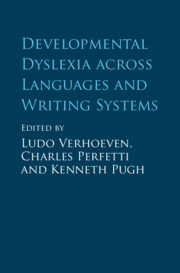Book contents
- Developmental Dyslexia across Languages and Writing Systems
- Developmental Dyslexia across Languages and Writing Systems
- Copyright page
- Contents
- Figures
- Tables
- Contributors
- 1 Introduction
- Part I Developmental Dyslexia across Languages and Writing Systems
- Part II Cross-Linguistic Perspectives on Developmental Dyslexia
- 11 Behavioral Precursors of Developmental Dyslexia
- 12 Neural Predictors of Developmental Dyslexia
- 13 Neurocognitive Markers of Developmental Dyslexia
- 14 Role of Visual Attention in Developmental Dyslexia
- 15 Morphological and Semantic Processing in Developmental Dyslexia
- 16 Modeling the Variability of Developmental Dyslexia
- 17 Modeling Developmental Dyslexia across Languages and Writing Systems
- 18 Etiology of Developmental Dyslexia
- 19 Intergenerational Transmission in Developmental Dyslexia
- Epilogue
- Index
- References
17 - Modeling Developmental Dyslexia across Languages and Writing Systems
from Part II - Cross-Linguistic Perspectives on Developmental Dyslexia
Published online by Cambridge University Press: 27 September 2019
- Developmental Dyslexia across Languages and Writing Systems
- Developmental Dyslexia across Languages and Writing Systems
- Copyright page
- Contents
- Figures
- Tables
- Contributors
- 1 Introduction
- Part I Developmental Dyslexia across Languages and Writing Systems
- Part II Cross-Linguistic Perspectives on Developmental Dyslexia
- 11 Behavioral Precursors of Developmental Dyslexia
- 12 Neural Predictors of Developmental Dyslexia
- 13 Neurocognitive Markers of Developmental Dyslexia
- 14 Role of Visual Attention in Developmental Dyslexia
- 15 Morphological and Semantic Processing in Developmental Dyslexia
- 16 Modeling the Variability of Developmental Dyslexia
- 17 Modeling Developmental Dyslexia across Languages and Writing Systems
- 18 Etiology of Developmental Dyslexia
- 19 Intergenerational Transmission in Developmental Dyslexia
- Epilogue
- Index
- References
Summary
Computational models of reading have played an important role in theorizing about developmental dyslexia. In particular, simulations of how children learn to read, based on Parallel Distributed Processing (PDP) principles, such as the triangle model (Seidenberg & McClelland, 1989) have been influential, because they hold the promise of explaining complex phenomena as emerging from a relatively simple set of assumptions. For example, Harm and Seidenberg (1999) demonstrated how lower-level perceptual difficulties that interfere with the formation of phonological categories can give rise to specific deficits observed in phonological dyslexia in English. The theory behind the triangle model is that reading skill emerges as a result of statistically driven learning of the mappings among the written and spoken forms of words and their meanings. At the computational level of analysis, this provides the basis for a universal model of reading across languages (e.g. Frost, 2012).
Information
- Type
- Chapter
- Information
- Developmental Dyslexia across Languages and Writing Systems , pp. 372 - 390Publisher: Cambridge University PressPrint publication year: 2019
References
Accessibility standard: Unknown
Why this information is here
This section outlines the accessibility features of this content - including support for screen readers, full keyboard navigation and high-contrast display options. This may not be relevant for you.Accessibility Information
- 1
- Cited by
